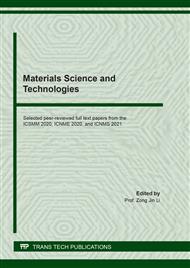[1]
W. Wang, et al., Enhancing the hydrophilicity and cell attachment of 3D printed PCL/graphene scaffolds for bone tissue engineering,, Materials 9(12) (2016) 992.
DOI: 10.3390/ma9120992
Google Scholar
[2]
A. Wibowo, et al., 3D printing of polycaprolactone–polyaniline electroactive scaffolds for bone tissue engineering,, Materials 13(3) (2020) 512.
DOI: 10.3390/ma13030512
Google Scholar
[3]
A. Wickham, et al., Electroactive biomimetic collagen-silver nanowire composite scaffolds,, Nanoscale 8(29) (2016) 14146-14155.
DOI: 10.1039/c6nr02027e
Google Scholar
[4]
A. Roy, et al., Green synthesis of silver nanoparticles: biomolecule-nanoparticle organizations targeting antimicrobial activity,, RSC Adv 9(5) (2019) 2673-2702.
DOI: 10.1039/c8ra08982e
Google Scholar
[5]
P. Raveendran, J. Fu, S.L. Wallen, Completely "green" synthesis and stabilization of metal nanoparticles,, J. Am. Chem. Soc. 125(46) (2003) 13940-13941.
DOI: 10.1021/ja029267j
Google Scholar
[6]
D. Philip, Honey mediated green synthesis of silver nanoparticles,, Spectrochmic. Acta A Mol. Biomol. Spectrosc. 75(3) (2010) 1078-1081.
Google Scholar
[7]
E.R. Balasooriya, et al., Honey mediated green synthesis of nanoparticles: new era of safe nanotechnology,, J. Nanomater. 2017 (2017).
Google Scholar
[8]
Y. Riswahyuli, et al., Indonesian wild honey authenticity analysis using attenuated total reflectance-fourier transform infrared (ATR-FTIR) spectroscopy combined with multivariate statistical techniques,, Heliyon 6(4) (2020) e03662.
DOI: 10.1016/j.heliyon.2020.e03662
Google Scholar
[9]
N.M.D.M.W. Nayaka, et al., Antioxidant and Antibacterial Activities of Multiflora Honey Extracts from Indonesian Apis cerana Bee,, J. Taibah Univ. Medical Sci. (2020).
DOI: 10.1016/j.jtumed.2020.04.005
Google Scholar
[10]
P. Gawali, B. Jadhav, Synthesis of Ag/AgCl Nanoparticles and their action on Human Serum albumin: A fluorescence study,, Process Biochem 69 (2018) 106-122.
DOI: 10.1016/j.procbio.2018.03.020
Google Scholar
[11]
H. Haiza, et al., Green synthesis of silver nanoparticles using local honey, Nano Hybrids, Trans Tech Publ, 2013, pp.87-98.
DOI: 10.4028/www.scientific.net/nh.4.87
Google Scholar
[12]
S. Iego, A guide to dynamic light scattering measurement and analysis, NanoComposix, (2012).
Google Scholar
[13]
O. Ahmadi, H. Jafarizadeh-Malmiri, N. Jodeiri, Eco-friendly microwave-enhanced green synthesis of silver nanoparticles using Aloe vera leaf extract and their physico-chemical and antibacterial studies,, Green Process. Synth. 7(3) (2018) 231-240.
DOI: 10.1515/gps-2017-0039
Google Scholar
[14]
E. Tomaszewska, et al., Detection limits of DLS and UV-Vis spectroscopy in characterization of polydisperse nanoparticles colloids,, J. Nanomater. 2013 (2013).
DOI: 10.1155/2013/313081
Google Scholar


